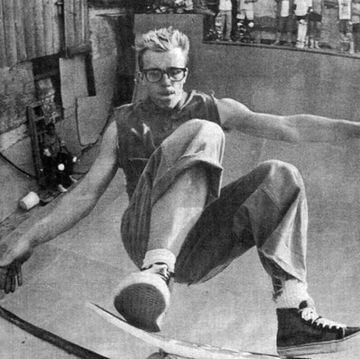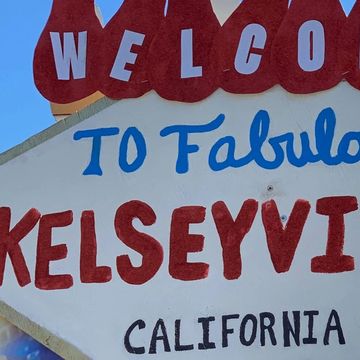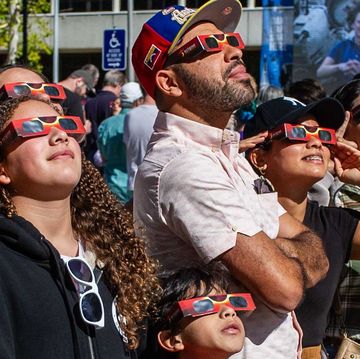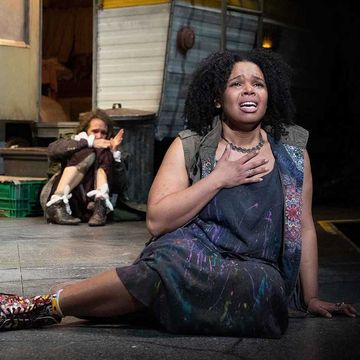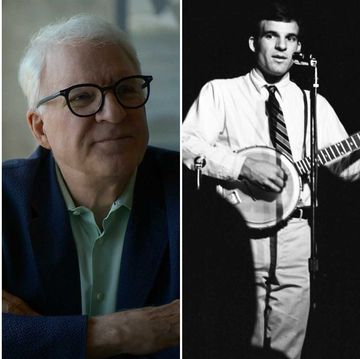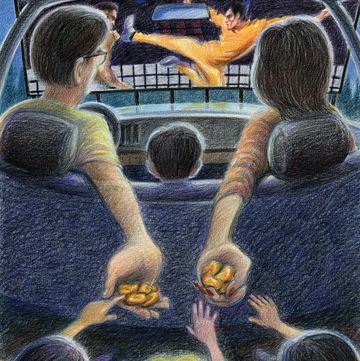The 1992 film American Me opens with a riot and a rape, and gets darker from there. Directed by and starring Edward James Olmos, the movie tries to present a fictionalized account of the origins of the Mexican Mafia in California—from Los Angeles’s Zoot Suit Riots in 1943 to the city’s gang wars of the 1990s—as a cautionary dirge.
But overwrought acting and directing coupled with corny dialogue (tell any group of Gen X Chicanos to “open your eyes, vato” and expect loud laughs) made the well-meaning American Me a box office disappointment.
This article was featured in Alta Journal's free Weekend Read newsletter.
SUBSCRIBE
Its title is now shorthand among Mexican Americans for ham-fisted moralizing, and the film lives in the shadow of the other cinematic 1990s Mexican Mafia origin story, the campy cult classic Blood In, Blood Out. But at least Olmos’s magnum opus is remembered. The same can’t be said for the other American Me, a 1948 book about Mexican American youths in L.A. that the people behind the film of the same peculiar name have long sworn is completely unrelated, despite the tome’s opening with—yep—a riot and a threatened rape.
Written by 39-year-old first-time author Beatrice Griffith, American Me the book is the opposite of its cinematic doppelgänger. It’s a bona fide tour de force, one of the rawest depictions of barrio life produced in any medium.
Griffith alternates between fictionalized vignettes of Chicanos in L.A. during World War II and nonfiction essays, packed with stats, about their community, long ostracized in Southern California. The short stories drill right into your conscience with pachuco lingo and expert heart tugs. A teenage girl runs away from her abusive home only to be roped into running drugs by a lecherous brother-in-law. Politicos exploit their immigrant constituents; police beat young men and women for the hell of it, because they know they can with impunity.
“None of it hurts like their [white people’s] hating you for your race,” a Purple Heart veteran sighs in one of Griffith’s vignettes. “It’s like Eddie said, ‘What did we win in this war? What was all the shooting about?’ ”
But Griffith, distinct from nearly all other white authors of the era who wrote on this subject, had faith that Mexican Americans would overcome a racist society. “They are sustaining their new dreams with new knowledge of American work habits, skilled trades, and organizational methods,” she writes in the book’s final section. “Like the Phoenix, they, too, are rising from their own ashes.”
Griffith’s American Me, unlike Olmos’s effort, was a hit. The Los Angeles Times called it a “very good book indeed,” and the Tidings, the influential newspaper of the Archdiocese of Los Angeles, pronounced it “powerful and moving.” It was turned into a play called The Sun Looks Down that had a pre-Broadway tryout in 1952. An abridged paperback edition sold more than 168,000 copies as a 1954 reissue. Hollywood legend Joseph L. Mankiewicz, he of All About Eve and The Barefoot Contessa, told the press he was interested in adapting American Me into a film to realize a longtime “pet project” of dramatizing Mexican American life in L.A.
“When I read her, I was like, ‘Wow, this woman captured us,’ ” says Arturo Madrid, a retired humanities professor who taught at Trinity University in San Antonio. His iconic 1973 “In Search of the Authentic Pachuco: An Interpretive Essay” praised American Me for its accuracy, describing Griffith as a “sensitive observer of social conflict.”
“We were not folkloric figures—‘Aren’t they cute? Aren’t they charming? Aren’t they brutes?’ ” Madrid says, comparing her depiction with many other non-Chicano writers’ portrayals then and now. “To Griffith, we were humans.”
This article appears in the Summer 2022 issue of Alta Journal.
SUBSCRIBE
Her work was one of the earliest English-language books to depict Mexican Americans positively and remains vital reading…if you can find a copy. American Me has largely disappeared, available only in university archives or for sale online for hundreds of dollars. Madrid’s essay is the only full-length examination of Griffith’s masterpiece I could find, and even he didn’t know what had become of the author after her early success.
When I tell him about her fate, he goes silent. “Oh, how dreadful!” he finally replies. “Pobrecita.”
Poor woman.
SOCIAL WRITER
Beatrice Winston Griffitts (she changed it to Griffith) was born in 1908 in Dallas to parents who soon moved to Riverside, California. She never attended high school, which became a problem when she sought to register for classes at Pomona College. The university president took pity on her—according to an undated biography by her husband, Don Scott Thompson, that’s in the UCLA Library Special Collections—and allowed Griffith to enroll.
She supported herself as a dance instructor throughout the Inland Empire, as a typist for Hollywood studios, and as a school cafeteria worker. She graduated with a sociology degree in 1933 and took a job as a social worker for the National Youth Authority. That job took Griffith to barrios in and around East Los Angeles like Happy Valley, Belvedere, and Maravilla, experiences that changed her life.
“I saw these fine people for what they are—hard-working, humble and with a naïve intelligence that needs only understanding and encouragement to make them succeed in many fields of endeavor,” she told a Santa Barbara newspaper years later. She became enough of an expert that when Wallace Stegner came to L.A. in 1945 to report on Chicanos for Look, he asked Griffith to be his guide. He ended up thanking her in One Nation, his essay collection about minorities in the United States.
Soon after, Griffith took a writing class with Stegner at Stanford University, and he urged her to focus on her former clients. Her fictionalized accounts of Chicano youths soon appeared in publications like Seventeen and the liberal magazine Common Ground; one made it into the Best American Short Stories series. Eventually, she compiled her writing into a manuscript that earned a literary fellowship from publisher Houghton Mifflin.
That manuscript turned into American Me.
“She has written her book so that Americans will understand these youngsters, and by understanding, help them to become the Americans they so want to be,” read the book’s back-cover copy. Above the blurb was a photo of Griffith, hair combed forward in a Bettie Page cut, lipstick on point, deep dark eyes looking straight at the reader.
American Me received national attention and sold out of its first printing, and Griffith’s literary career seemed limitless when she visited 20th Century Fox in the spring of 1950 to take a meeting with a producer about turning the book into a film. According to her husband’s bio, the producer, unnamed but possibly Mankiewicz, “began remarking that all Mexicans were lazy and thieving. Upon hearing this canard, she had such a surge of blood, driven by anger, that a clot…lodged in the right side of her brain,” leaving her left side paralyzed.
Friends, fans, and former clients quickly formed a committee to raise funds for Griffith’s recovery. “I know now why the Spaniards say God never sends a wound without sending the medicine to cure it,” she’d later tell a reporter.
But it would be a year before Griffith could walk again—and she never fully regained the use of her left hand.
The stage version of American Me never made it to Broadway—syndicated gossip columnist Walter Winchell dismissed it as “a play which starts from nowhere and never gets much further.” Griffith planned to come out with a second book, a novel about a young Mexican American girl. “My original aim in life was to be a great actress,” she told the Pomona Progress Bulletin in 1953, “but I am sure I am much happier being a writer.”
Griffith never published again.
RESPECT.
In the 1960s, Griffith and her husband moved to near Bend, Oregon, where she spent the rest of her life taking care of foster children. By then, the Chicano movement had rediscovered American Me, and Griffith’s work was cited in early Chicano studies anthologies. But it was a short renaissance.
“Chicanos wanted to do their own interpretation, be interpreters of their own experience,” Madrid says, trying to explain why American Me isn’t remembered. “I was part of that ola [wave]—we would interpret our experiences instead of others. But certainly, I was deeply respectful and in awe of what she had done.”
Griffith’s personal letters and her husband’s tribute hint at two other projects she tried to pursue while in Oregon: a study about foster children in the United States and a play about Mexican American migrant workers. There is no record of the former, and the latter was never staged because of local opposition, according to her husband’s account. She died of a heart attack in 1976, at age 67.
Edward James Olmos didn’t return multiple emails requesting comment. I get it. If the public rediscovers Griffith’s American Me, it will find it a far superior work to Olmos’s film and wonder how a white woman in 1940s America could better capture Mexican American life than the greatest living Chicano actor.
Open your eyes, vatos.•
Gustavo Arellano is the author of Orange County: A Personal History and Taco USA: How Mexican Food Conquered America. He is a features writer for the Los Angeles Times and has been an essayist and reporter for various publications as well as a frequent commentator on radio and television. He was formerly editor of OC Weekly, an alternative newspaper in Orange County, California, and penned the award-winning “¡Ask a Mexican!,” a nationally syndicated column in which he answered any and all questions about America's spiciest and largest minority. Gustavo is the recipient of awards ranging from the Association of Alternative Newsweeklies Best Columnist to the Los Angeles Press Club President's Award to an Impacto Award from the National Hispanic Media Coalition, and was recognized by the California Latino Legislative Caucus with a 2008 Spirit Award for his “exceptional vision, creativity, and work ethic.” Gustavo is a lifelong resident of Orange County and is the proud son of two Mexican immigrants, one whom came to this country in the trunk of a Chevy.





